![]()
All illustrations on this page are thumbnails. Left-clicking on them will bring up larger images.
![]()
![]()

First MU vs KU Homecoming Game, 1911
(University Archives, C:22/1/3)
The 1911 University of Missouri football game against
the University of Kansas began an enduring
Tiger tradition. Before that year, the MU versus KU
game had always been played in Kansas City. The 1911 season,
however, saw a change in conference regulations. All
intercollegiate football games were required to be played
on campus. Fearing that game attendance would be low, the
new MU coach, C. L. Brewer, appealed with great success
for the "Old Grads" to "Come Back Home" to boost attendance
and help dedicate MU's new football field. MU fans responded, swelling the crowd at Rollins Field in Columbia to more than ten
thousand. Once there, they demonstrated their support vocally,
cheering the Tigers on to a hard-fought, 3-3 tie with KU.
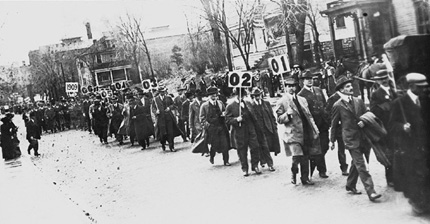
"Old Grads" Parade before the MU vs. KU Homecoming Game, 1913
(University Archives, C:0/3/7)
The "home coming" celebration found immediate favor as a time to
celebrate and reminisce. Until the 1920s, though, Homecoming against Kansas was only celebrated on alternate Thanksgivings, when the Tigers hosted the JayHawks at MU.
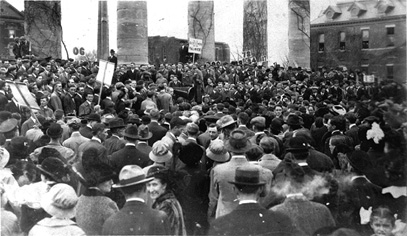
Mass Meeting of MU Boosters Before the MU vs. KU Homecoming Game, 1913
(University Archives, C:0/3/7)
Though homecoming was canceled in
1918, when an influenza epidemic was raging, and the location was changed in 1944 to save gasoline for the war effort, this Tiger tradition continues to thrive today. Kansas, Oklahoma and Nebraska have become MU's favorite homecoming rivals.
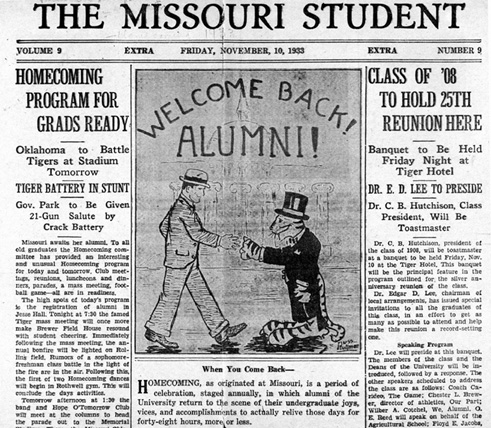
The Missouri Student Welcomes MU Graduates to Homecoming, 1933
(University Archives, C:0/49/2)
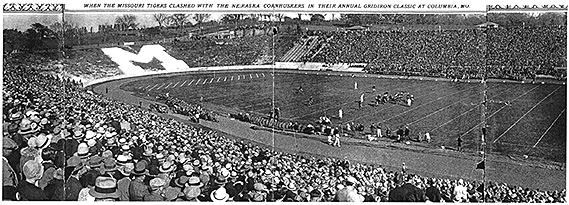
Ten thousand fans attended the University of Missouri's homecoming game in 1911, thirty-two thousand came in 1948, and in 1997, over 48,000 watched MU beat Texas 37-29.
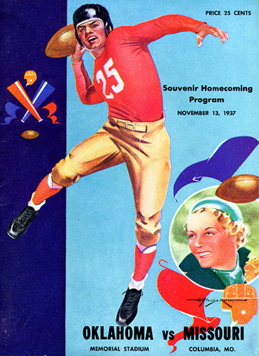
Cover of the 1937 Homecoming Program
(University Archives, C:22/8/8)
Before the modern highway system was developed most out of town
guests, including the opposition team, arrived by special trains
added to handle the sudden influx. The festivities began days
before the football game with alumni pouring into Columbia by the
thousands.
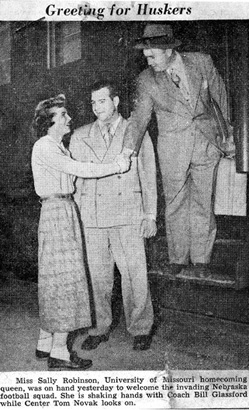
MU Homecoming Queen, Sally Robinson,
Greets University of Nebraska Players and Coach, 1949
(University Archives, C:1/141/1)
After the former students were registered, the
celebration began with open house receptions, luncheons, dinners, concerts, mass meetings,
dances, parades, plays, class reunions, and, often, dedications or
the laying of cornerstones of new MU facilities, such as the
Memorial Tower and the Memorial Stadium.
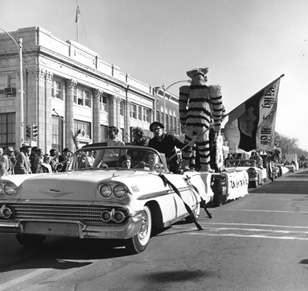
The 1963 Homecoming Parade Draws Crowds in Downtown Columbia
(University Archives, C:1/141/6, Box 4a, FF Homecoming MO vs. Neb)
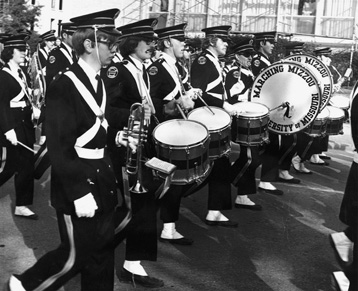
MU's Marching Band in the 1969 Homecoming Parade
(University Archives, C:3/5/1)

Art students' Homecoming Parade Float, 1954
(University Archives, C:0/3/8)
![]()
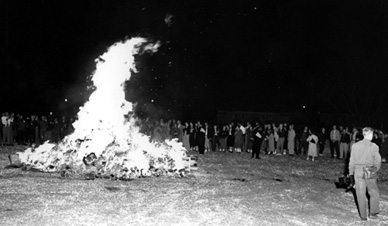
University of Missouri Homecoming Bonfire, 1954
(University Archives, C:1/141/6)
By the first celebration in 1911 a bonfire was already an
important and well established event used to celebrate Tiger
football games. That year a torchlight parade marched from the
"mass meeting" pep rally to Rollins Field where the fire was set
ablaze while students snaked danced around it and later roasted
Jayhawks.

MU's Much-Admired Head Football Coach, Dan Devine, 1968
(University Archives, C:31/00/2)![]()
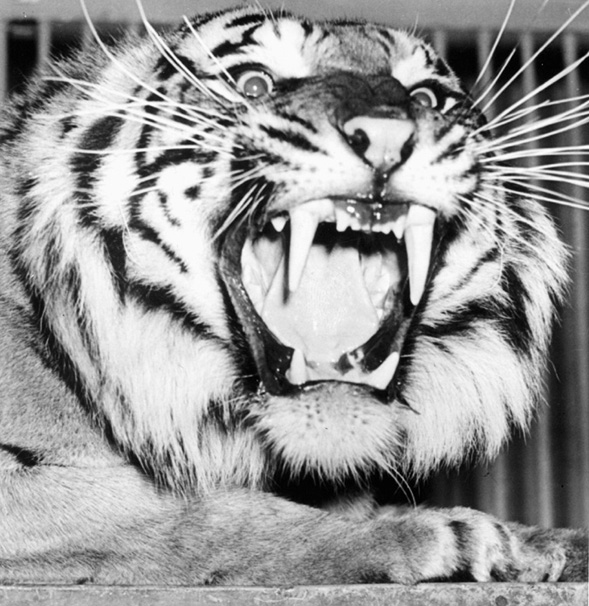
The University of Missouri Tiger Shows his Fangs
(University Archives, C:1/141/8)
The bonfire was not without problems, however. In 1931 three students caused great consternation when they lit the fire the night before the big rally. About a hundred students came to the rescue working through the night to rebuild the pyre; later in the afternoon all male students were excused from class to help and finished preparations just in time for the mass meeting.
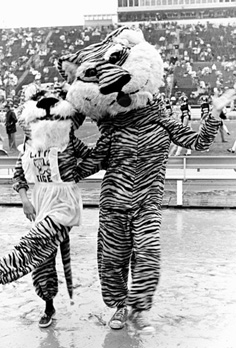
The 1974 Homecoming Version of the Tiger Mascot (with Lil Tiger)
(University Archives, C:1/139/1)
By the 1940's, the freshman class had formed their own pep club, the "Thundering Thousand," which marched in "lock step" from the columns to the stadium. The mass meeting pep rallies before the game came to be known as the "Romp, Stomp, Chomp!" by the 1950's.
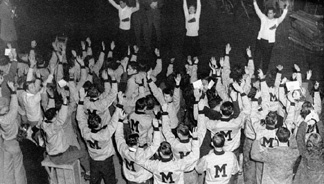
Homecoming "Romp, Stomp, Chomp!" Rally in Brewer Field House, 1946
(University Archives, C:22/1/1)![]()
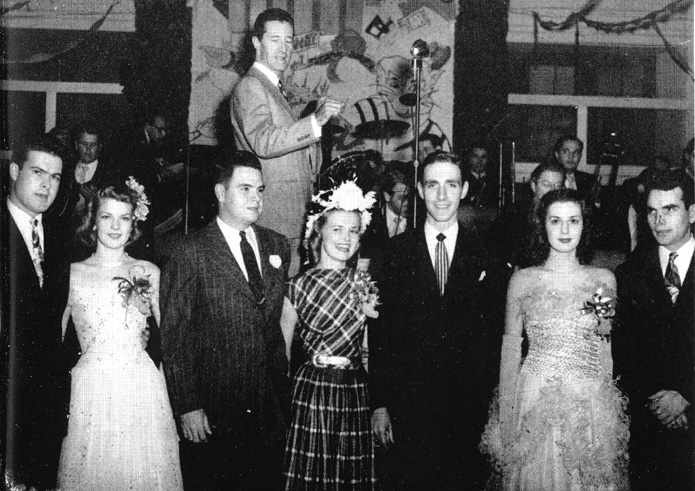
Queen Peggy Field, and her Entourage
Pose in Front of Band Leader, Ray McKinley
at the 1947 Homecoming Dance
(University Archives, C:22/1/1)
New traditions also grew in popularity. The "all-school" homecoming dance, which began in 1928, and house decorations, which began to appear in 1935, became established over the years. The homecoming queen, first photographed for the 1937 Savitar, gave way, in 1977, to a new tradition, the election of a homecoming king and queen.
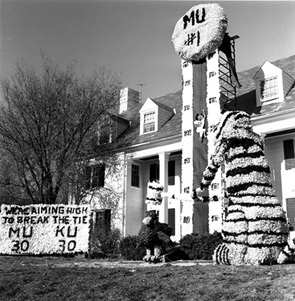
Lambda Chi Alpha Greek House Decorated for Homecoming, 1960
(University Archives, C:1/141/6)
Some traditions are no longer practiced, including the sounding of
taps in memory of MU students who lost their lives in the nation's wars. A
"coming-home" alumnae queen is no longer chosen to rule with the student queen.
Freshmen no longer toss their class beanies into the homecoming bonfire.
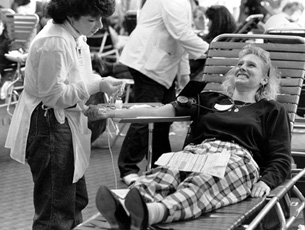
Giving Blood, a New Homecoming Tradition
(University Archives, C:22/1/5)
University of Missouri students today are creating new homecoming traditions.
The classic celebration has been revitalized by such new activities as collecting macaroni and cheese for local food banks and participating in Red Cross blood drives. These creative applications of the enduring MU spirit will assure a "home coming" tradition remains alive and growing at the University of Missouri.
![]()
muarchives.missouri.edu/exhibitlist.html
